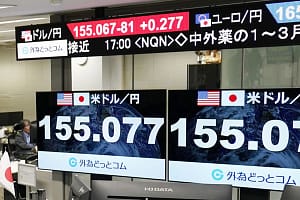On 28 June, the European Commission announced plans to create a “digital Euro”. At the same time, it reasserted its commitment to safeguarding the legal status of euro notes and coins, in line with the expectations of the ECB and the case law of the CJEU. Eric Boissonnas, CEO of KBBS, has every reason to be pleased with this decision. The printing machines manufactured by his company are involved in the production of banknotes in almost every country in the world. We caught up with him to find out more about the key role played by banknote printing and some of the intricacies of the business.
Not so long ago, people were saying “it’s the end of cash”. Why is it so resilient in the face of digital payment methods?
Banknotes are still the currency of trust. This is true even in the most advanced countries where electronic payments are gaining ground, because banknotes and coins represent a store of value. In the European Union, only 25% of euro notes are used for transactions, while 50% are used as a store of value. This trend was highlighted during the COVID pandemic, and is prompting countries that have made progress in paperless transactions to take a step backwards, such as Sweden, which is introducing laws to force shops to accept cash. In the United States, cash is essential for the 20% of people who do not have access to all banking services, in terms of both transactions and reserves. Apart from the most advanced countries, cash is ever-present, accounting for more than 90% of transactions, a constant that is not fundamentally challenged by initiatives to move towards electronic transactions.
So the market remains buoyant despite the rapid shift towards electronic transactions?
There is no doubt that the last decade has seen an increase in the number of projects for new printing works initiated by central banks. There are currently around ten countries with recently completed projects, including Mexico, Spain and Egypt, with varying degrees of maturity: France, the United States, Poland, Pakistan, Vietnam, the Philippines and Algeria.
Beyond these infrastructure projects, demand is generally driven by two key factors: economic growth and population growth. We estimate that demand for banknotes will grow by 3% a year in countries that combine these two factors, i.e. 80% of the world’s population.
Why do some countries print their own banknotes, while others choose to outsource production?
By 2023, only 60 countries will be printing their own banknotes. It is essentially a question of volume and cost. Globally, it is estimated that 20 banknotes are produced per inhabitant each year, with a variation of between 7 and 30 depending on the quality of the banknotes and the conditions in which they are used. Since a printing line produces between 500 and 800 million banknotes a year, we consider that the critical population threshold is 30 million inhabitants for a country to have a state printing capacity. This is borne out by the fact that only seven countries in the world with a larger population have not acquired a printing capacity: Malaysia and six African countries, including Ethiopia and Uganda. By contrast, countries with small populations, such as Switzerland, print for others.
What does this market represent for the Koenig & Bauer Group?
The manufacture of banknote printing equipment is still a niche market, with only 25 to 30 machines produced each year, but the level of demand is very high. The specific features of the equipment needed, along with the level of service demanded by state and private printers, require considerable investment on the part of the world’s two manufacturers of banknote printing machines, of which we are one, along with the Japanese company Komori. A Chinese company, which is active in its domestic market, has tried its hand at international expansion, but so far to no avail. In such a sensitive field, relations between customers and suppliers are guided by the reputation acquired through experience with an ever-wider range of customers. KBBS and Komori can draw on 70 and 50 years’ experience respectively in this field.
Given that you are working in a sovereign capacity, what requirements must machine manufacturers comply with?
For example, they are linked to the exclusive nature of the security features that we supply to our customers or that our equipment incorporates into the banknote. KBBS is the exclusive supplier of certain technologies, such as screen printing for an optical security feature used in more than 100 countries, an offset printing process enabling us to print up to 10 different inks, sometimes spaced one-micron apart, or the very precise application of holograms… We are the only company offering its customers an integrated, modular, and scalable solution for every stage in banknote printing, a key factor in monitoring production and quality data.
In addition to technical requirements, customers are placing increasing emphasis on compliance, by referring to global reference standards. Complying with these requirements is not optional, it is a necessity! We have anticipated and supported this trend, since we were among the first to be certified under the Banknote Ethics Initiative (BnEI), which carries out a full, independent audit every three years, and the Koenig & Bauer Group is ISO 37001 certified in terms of anti-bribery and corruption, which is currently being awarded to our subsidiary.
Does the acquisition of printing machines account for most banknote production costs?
Definitely not! As in other sectors, we need to distinguish between the cost of acquiring machines and the cost of running them – the well-known total cost of ownership. The depreciation of the machines represents only 10 to 15% of the cost of the banknote. The rest, most of it, is made up of the cost of consumables, such as substrate or inks, or operating costs: labour, energy, equipment maintenance and upgrades, etc.
However, in some calls for tender there is a tendency to make the price of the machines an essential criterion for choice. In our opinion, this is a mistake that can have uncontrolled repercussions on the total cost of a printing plant project, since it creates the illusion of savings by ignoring the “hidden costs”. In practice, this is also reflected in the temptation to create “hybrid” printing infrastructures, using different pieces of equipment side by side to optimise renewal or acquisition costs. This generally affects the overall efficiency of printing, because banknotes of different qualities can lead to considerable additional operating costs, at the end of the production chain (number of errors), in the circulation of banknotes, as well as in staff training, maintenance of facilities, or the stock of spare parts due to duplication of equipment!
In addition, the acquisition cost must enable manufacturers to finance R&D. We invest around 15% of our turnover in R&D, in particular to prevent the risks associated with counterfeiting and to maintain the monetary credibility of governments. It is imperative for counterfeiting to remain very low in order to guarantee trust in the banknotes in circulation.
How are you adapting to this commercial pressure?
We are not just offering machines, but an integrated, modular system that will support our customers’ banknote production for 15 to 20 years. Instead of sweeping hidden costs under the carpet, we integrate them into our offer, including delivery of the machines, initial and ongoing training of operators, and upgrading of production lines to incorporate our latest innovations.
For some years now, we have also been offering them a local service that takes account of local constraints, provides maintenance as close as possible to requirements, and proactively supports them in all aspects of the system’s lifecycle, which is vital to each country’s economic development. Central banks’ need to satisfy the public’s demand for banknotes is not compatible with equipment being out of service while waiting for a spare part, for example. Our new organisation means that we can work more closely with our customers, provide better follow-up, ensure that our technicians are on site more frequently, and carry out ongoing optimisation projects… All of these are guarantees of performance and trust. We can count on several dozen technicians dedicated to banknote printing!






Leave a Comment